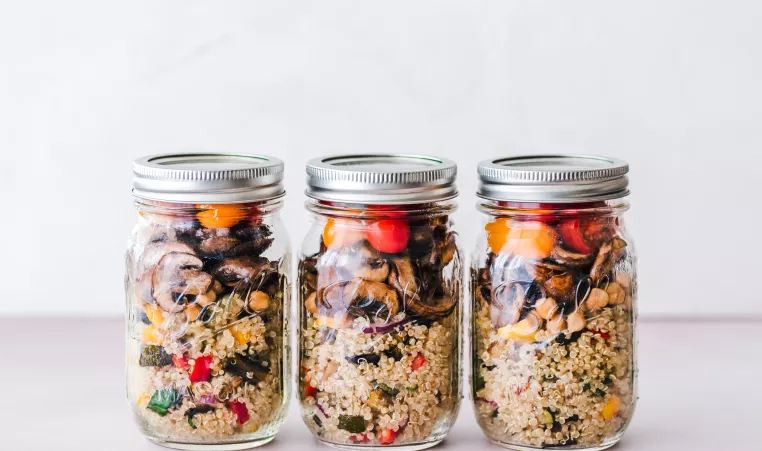
Healthy Eating Tips for the Fall
Fall brings shorter days, longer nights, cooler weather and the beginning of the school year. It also brings a new menu of seasonal foods. Often in the fall something else happens: many of us start eating more and not as healthy. Research shows that the average person increases total caloric consumption in the fall. This can be a result of an increase in meal size, less healthy choices and a greater frequency of eating. Why do we eat more in the fall? Sometimes with the cooler, shorter days we eat more high calorie “comfort” foods. There may also be a correlation to the decreased amount of daylight and more time spent indoors with less exercise. Also, in the fall our schedules often get busier, and we may have less time for healthy meal prep.
The following are some helpful nutrition tips to eat healthier this Fall:
- Fill up on fall produce: Enjoy the flavors of fall by sampling in-season produce. Items such as apples, pears, pumpkin, sweet potato, butternut squash, spaghetti squash, beets, cranberries, and kale are in-season in the fall. They are packed with great nutrients, such as fiber, protein, beta carotene and vitamin C.
- Flavor your fall: Get creative with smoothies, oatmeal, pancakes and even roasted vegetables by adding fall spices such as cinnamon, clove, nutmeg, allspice, and ginger.
- Fuel with whole grains: Whole grains are a fantastic way to fuel up this fall. They provide carbohydrates for energy and fiber for digestive health. The cooler weather is a great time to enjoy grains such as steel cut oats, barley, rye, brown rice, or quinoa.
- Choose smart snacks: It is easy to reach for potato chips while you’re watching the game, but processed foods won’t help with your weight loss goals. Instead reach for healthier snacks such as veggies & hummus, mini turkey sandwiches, or popcorn.
- Don’t forget the fluids: Chapped lips and dry skin can be a result of harsh weather, but they can also signify dehydration. Without the summer heat it can be harder to remember to drink enough water. Hot tea can warm you up and provided needed fluids.
- Increase immunity against illness by having a diet that includes plenty of Vitamin A (pumpkin, sweet potato, carrots), Vitamin E (sunflower seeds, almonds, hazelnuts), Vitamin C (citrus fruit, bell peppers) and Zinc (meat, seafood, beans).
- Halloween is only one day. So why do we eat candy all month long? Keep the candy out of the house until Halloween. Let yourself eat a few of your favorites but give the last trick-or-treater the rest at the end of the night. If your kids bring home a bounty have the “Candy Fairy” trade it in for a toy overnight and ditch or donate the rest.
- Take a Moment: Often, we eat food while distracted by something like our phones, TV etc. Try to avoid unconscious eating while watching football or the new fall TV lineup. Never bring the whole bag or bowl of anything to the couch or coffee table. Instead, pre-measure it in the kitchen beforehand. Really appreciate your food as you eat it. This will help you realize you’re full faster.
- Time Change: Keep in mind that once we set the clocks back, it gets darker earlier, so there are fewer outdoor options for physical activities in the evening. Make adjustments by going to the Y, planning evening walks at the mall or becoming an early riser.
- You can still enjoy your fall favorite dishes in moderation or give them a healthy boost: We all have fall favorite dishes. You can include these dishes and comfort foods sometimes but pay attention to serving sizes. There are ways to boost the health of your favorite fall dishes and desserts. Here are just a few examples.
Healthier Stew and Soups
- Cut fat by buying leaner meat and/or lentils. Avoid soups and stews with lots of cream and cheese replace with low fat dairy.
- Throw in extra veggies.
- Use the Harvest: Go beyond carrots and onions. Add some seasonal veggies — like butternut squash.
- Lean on herbs for flavor instead of salt and fat.
- Decrease sodium: if buying broth, soups, or stew buy low-sodium.
Healthier Fall Lattes
- Order one of the smaller sizes offered.
- Choose Skim or Nut Milks
- Ask for Less Syrup
- Drink slowly
Healthier Fall Desserts
- Use the Quarter Rule: If the recipe calls for a full cup of sugar, use ¾.
- Choose Fruit-based Desserts
- Stay Seasonal
- Use fruits that are in season: apples, pears, cranberries.
- Try making pumpkin pie with egg whites and low-fat milk.
- Cutdown the Crust: Avoid or lessen streusels and crusts to decrease sugar, fat, and calories.
- Only Take One: for instance, eat only one piece of pie
Roasting Pumpkin Seeds: first rinse to remove pulp and strings. Spread seeds on a baking sheet that has been coated with cooking spray or drizzle a small amount of olive oil over seeds. Bake at 325°F for about 30 minutes or until lightly toasted. Stir occasionally during cooking. Take a look at your spice rack and try a seasoning on your toasted seeds such as garlic powder or Cajun seasoning.
By Traci McIntosh, MA, RD East Area YMCA Dietitian
* A registered dietitian (RD) is your best source for reliable and up-to-date food and nutrition information. A dietitian can help you identify measurable and achievable goals as well as develop a plan to achieve them with support along the way. For more information or for a nutrition consultation with Traci McIntosh, MA, RD please contact Kim Leonard East Area YMCA Health and Wellness Director at 315-637-2025 X220 or kleonard@ymcacny.org